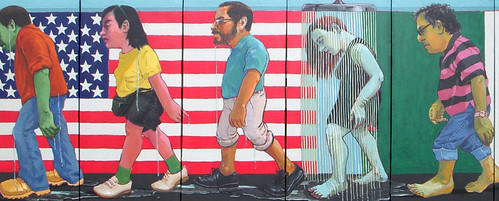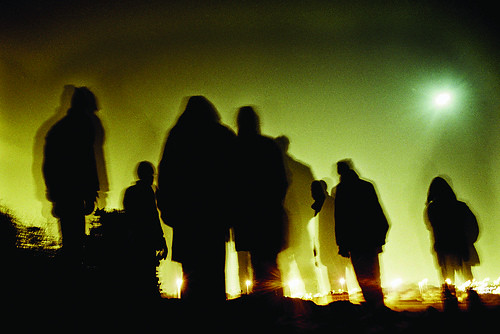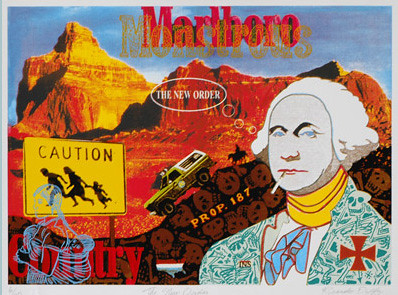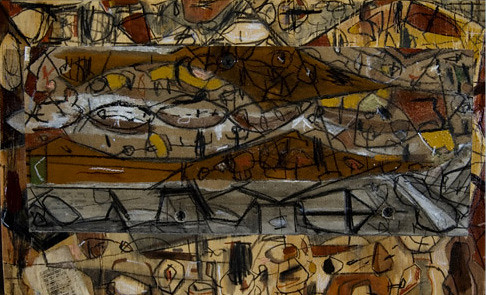Of Declarations and the Immigrant Imaginary
Real quick, here's some bits and pieces on a few exhibitions I have already missed, or that I might still miss, or that are just in places between missed and missing; and, that if I could I would catch up to, or go back and visit. And it goes without saying, that I am sure I even missed a few others, too.

A Declaration of Immigration at the National Museum of Mexico Art in Chicago.
Declaration of Immigration
Human progress having been comprised by the lack of humanity and respect towards immigrant children, women, & men by anti-immigrant legislature & rhetoric, is reason for the National Museum of Mexico Art to re-affirm the following:
We hold these truths to be self-evident, that all people are created equal and that they are endowed by their Creator, certain unalienable Right, that among them are Life, Liberty, and the Pursuit of Happiness.
Immigrants have endured patient sufferance; and as such, it behooves our government to redeem itself from repeated injuries and usurpations, in recognizing:
• That we are a nation of immigrants
• That no human being is illegal
• That inhumane treatment, detention, deportation, and family separation by government agencies denies immigrants of their unalienable rights
• That historically, immigration laws began as a method of racial exclusion and currently exist to dehumanize immigrants, (i.e. immigration raids, internment camps) under the guise of national security, thus creating inter-ethnic tension and hostilities.
• That the construction of The Wall along the United States-Mexico borders would stand as a symbol of persecution, much like the 20th century Berlin Wall.
The Declaration of Immigration to all whom have marched and petitioned against anti-immigrant legislature & rhetoric. As well, the Declaration of Immigration is a reminder, to all those who have persecuted immigrants, of the circumstances of emigration and settlement in the United States of America.
With the Declaration of Immigration, we appeal to the U.S. sense of justice and magnanimity, and hope to conjure all by the ties of our common kindred to disavow anti-immigrant sentiments and support just laws that persons with dignity & respect.
Therefore, we solemnly resolve, and invite everyone to join in Solidarity:
• To stand by a government and elected officials that uphold laws that treat immigrants with dignity and respect.
• To reflect on the immigrant experience, as the experience of the United States of America, one that honors the history of the native nations, and the cultural contributions of all who live in this country.
• To engage in civic dialogue that is thoughtful, inclusive, and that speaks to the realities of immigration, rather than the exclusion of it.
And for the support of this Declaration, with a firm reliance o the fellowship of all those that hold us goodwill, we mutually pledge to uphold the fight for equality and defend the unalienable rights of all.
National Museum of Mexico Art
More reading:
Art on the side of immigrants (Socialist Worker)
A Nation of Everybody: A Chicago art exhibit stirs dialogue on immigration reform (Miami Herald)
In Chicago, Art That's Yearning to Breathe Free (Washington Post)

"Laberinto de Miradas" (Labyrinth of Glances)
AP: From the fear-struck eyes of a Senegalese man waiting to scale a wire fence into Europe to the blank stare of a Russian housewife in Panama, a provocative exhibition setting off from Mexico explores the many faces of one of the world's pressing issues -- immigration.
The collection of photos and videos entitled "Laberinto de Miradas", or Labyrinth of Glances, will be shown in more than 20 countries over the next three years.
The ambitious project was the brainchild of Spanish photographer Claudi Carreras, who spent two years criss-crossing Latin America and Europe to go beyond the stereotyped news photos and capture the drama and deeper questions of identity facing those who leave home.
Event Blog

Caras Vemos, Corazones No Sabemos (Faces Seen Hearts Unknown): The Human Landscape of Mexican Migration
October 5–December 28, 2008 / Fowler Museum at UCLA
Caras vemos, corazones no sabemos/Faces Seen Hears Unknown: The Human Landscape of Mexican Migration considers Mexican migration into the United States—one of the defining factors in America’s and especially California’s socio-political landscape—as seen through Chicano/Mexican visual arts. Featuring paintings, works on paper, photographs, video, and installations, this bilingual exhibition explores the struggles and visions of migrants as well as the ways their spiritual practices are engaged during difficult journeys. More than forty artists—including Maria Elena Castro, Felipe Ehrenberg, Gronk, Salomón Huerta, Magú, Delilah Montoya, Malaquías Montoya, Victor Ochoa, and Patssi Valdéz—consider themes of journeys, boundaries and barriers, urban landscapes and human geographies, and the negotiation of identities in works dating from the 1970s to the present.
The title phrase “Caras vemos, corazones no sabemos” is taken from one of the most popular dichos, or sayings, in Mexico and in Chicano/Mexican communities in the U.S. It translates to “faces seen, hearts unknown,” and refers to superficial judgments made about people, based solely on appearances. This dicho cautions that in order to truly know a person or a community, one needs genuine access to their emotions. As such, this exhibition seeks to facilitate deep, human contact with the heart of Mexican migration to the United States.
The exhibition opens with an introduction to the general theme of the journey, and explores the mythical and everyday experiences of people immersed in migratory experiences. Christina Shallcross’s installation of votives covered with harsh scenes of border crossings provokes consideration of the meanings of migrants’ votive petitions for safe crossings. Also in this section is Malaquías Montoya’s iconic serigraph Undocumented (1981), in which barbed wire crisscrossing the image of a person is a direct reference to the walls, fences and wire mesh that divide Mexico from the United States. Humor comes into play, as well, in the work of comic creator Lalo Alcaráz, whose daily syndicated strip La Cucaracha provides a pop culture outlet for the expression and consideration of issues pertaining to Mexican migration.
The next section touches on the barriers and limits—physical, social, cultural, and geopolitical—that are found along migratory routes. Ricardo Duffy’s silkscreen The New Order casts George Washington as the symbol of the United States experience, while popular imagery such as the Marlboro logo, the Caltrans sign of undocumented immigrants running across a road, and a Western landscape littered with skulls depict a not-so-glorious American culture.
The works in the section “Human Geographies” explore the transformations of the migrants’ cultural values, institutions, and symbols. Everyday objects emerge as points of entry into a personal geography marked as much by the trauma of the crossing as by the faith in a prosperous and peaceful future. A new mixed media installation created by Maria Elena Castro for the Fowler’s presentation is titled Green, Go!, and addresses notions of immigrating for opportunity, as well as the clash of colliding identities and perceptions.
In “Negotiating Identity,” artists including Alejandro Almanza, Esperanza Gama, and Maceo Montoya examine the fragmentation, dislocation, and rearticulation of old identities into new and complex ones. In the final section visitors enter the realm of memory, where artists consider how we understand our past while positively moving into the future. Here six photographs from Dulce Pinzón’s whimsical yet poignant series La verdadera historia de los superhéroes (The True Story of Superheroes) depict comic book protagonists and masked Mexican luchadores in the most common of circumstances, washing clothes in a Laundromat, unpacking boxes of vegetables in New York, and working as doormen.
- UCLA Press Release

"Immigrant Imaginations and Imaginaries" by Tomás Ybarra-Frausto
In the places where we live and work we are conscious of evolving, trans-local economic and social processes. Worldwide circular migration patterns are a fact of daily life. "Having long boasted of being Mexico’s second city, Los Angeles now also has a Salvadorian population equal to or greater than San Salvador. New York City meanwhile, has almost as many Puerto Ricans as San Juan and nearly as many Dominicans as Santo Domingo, while New Orleans is the second city of Hondurans"1 ...and so it goes throughout the land. So where are Mexico, Puerto Rico, El Salvador? The answer is that they are both "here" and "there." Through continual migration Latin America has seeped into the United States. The "Latinization" of our country and the "Americanization" of Latin America is a firm reality, and established notions of identity, belonging, and citizenship no longer correspond to the expected historical-social scenarios.
In the current social arena, migratory flows and the constant movement of people and ideas across hemispheric borders position contemporary Latino(a) experience and cultural expression as part of an incipient transnational imaginary. Today’s Latino(a) culture is nurtured within translocal spaces and is vibrant in the formation of new, mobile identities, nascent coalitions and solidarities, and possible social formations of connection, communication, and conciliation within national groups and across borders.
The exhibition Caras Vemos, Corazones No Sabemos/Faces Seen, Hearts Unknown is a comprehensive archive and imagebank that documents and validates artistic expression about immigration experiences between Mexico and the United States. The curatorial essays included here contextualize the artworks within social and aesthetic frameworks.
This prologue posits that the repertoires of visual art presented in the exhibition can be further contextualized by acknowledging the creative capacities of immigrant imaginations within a historical dimension, and by understanding the cultural dynamics of everyday life in contemporary transnational communities.

Related:
The Art of Jumping Fences :: Fronteres :: Three Exhibits: On Walls and Political Divide :: Strange New World :: MexiCali Style :: Non-borders, run-on borders, and anti-borders :: Just Space(s) :: US/THEM

A Declaration of Immigration at the National Museum of Mexico Art in Chicago.
Declaration of Immigration
Human progress having been comprised by the lack of humanity and respect towards immigrant children, women, & men by anti-immigrant legislature & rhetoric, is reason for the National Museum of Mexico Art to re-affirm the following:
We hold these truths to be self-evident, that all people are created equal and that they are endowed by their Creator, certain unalienable Right, that among them are Life, Liberty, and the Pursuit of Happiness.
Immigrants have endured patient sufferance; and as such, it behooves our government to redeem itself from repeated injuries and usurpations, in recognizing:
• That we are a nation of immigrants
• That no human being is illegal
• That inhumane treatment, detention, deportation, and family separation by government agencies denies immigrants of their unalienable rights
• That historically, immigration laws began as a method of racial exclusion and currently exist to dehumanize immigrants, (i.e. immigration raids, internment camps) under the guise of national security, thus creating inter-ethnic tension and hostilities.
• That the construction of The Wall along the United States-Mexico borders would stand as a symbol of persecution, much like the 20th century Berlin Wall.
The Declaration of Immigration to all whom have marched and petitioned against anti-immigrant legislature & rhetoric. As well, the Declaration of Immigration is a reminder, to all those who have persecuted immigrants, of the circumstances of emigration and settlement in the United States of America.
With the Declaration of Immigration, we appeal to the U.S. sense of justice and magnanimity, and hope to conjure all by the ties of our common kindred to disavow anti-immigrant sentiments and support just laws that persons with dignity & respect.
Therefore, we solemnly resolve, and invite everyone to join in Solidarity:
• To stand by a government and elected officials that uphold laws that treat immigrants with dignity and respect.
• To reflect on the immigrant experience, as the experience of the United States of America, one that honors the history of the native nations, and the cultural contributions of all who live in this country.
• To engage in civic dialogue that is thoughtful, inclusive, and that speaks to the realities of immigration, rather than the exclusion of it.
And for the support of this Declaration, with a firm reliance o the fellowship of all those that hold us goodwill, we mutually pledge to uphold the fight for equality and defend the unalienable rights of all.
National Museum of Mexico Art
More reading:
Art on the side of immigrants (Socialist Worker)
A Nation of Everybody: A Chicago art exhibit stirs dialogue on immigration reform (Miami Herald)
In Chicago, Art That's Yearning to Breathe Free (Washington Post)

"Laberinto de Miradas" (Labyrinth of Glances)
AP: From the fear-struck eyes of a Senegalese man waiting to scale a wire fence into Europe to the blank stare of a Russian housewife in Panama, a provocative exhibition setting off from Mexico explores the many faces of one of the world's pressing issues -- immigration.
The collection of photos and videos entitled "Laberinto de Miradas", or Labyrinth of Glances, will be shown in more than 20 countries over the next three years.
The ambitious project was the brainchild of Spanish photographer Claudi Carreras, who spent two years criss-crossing Latin America and Europe to go beyond the stereotyped news photos and capture the drama and deeper questions of identity facing those who leave home.
Event Blog

Caras Vemos, Corazones No Sabemos (Faces Seen Hearts Unknown): The Human Landscape of Mexican Migration
October 5–December 28, 2008 / Fowler Museum at UCLA
Caras vemos, corazones no sabemos/Faces Seen Hears Unknown: The Human Landscape of Mexican Migration considers Mexican migration into the United States—one of the defining factors in America’s and especially California’s socio-political landscape—as seen through Chicano/Mexican visual arts. Featuring paintings, works on paper, photographs, video, and installations, this bilingual exhibition explores the struggles and visions of migrants as well as the ways their spiritual practices are engaged during difficult journeys. More than forty artists—including Maria Elena Castro, Felipe Ehrenberg, Gronk, Salomón Huerta, Magú, Delilah Montoya, Malaquías Montoya, Victor Ochoa, and Patssi Valdéz—consider themes of journeys, boundaries and barriers, urban landscapes and human geographies, and the negotiation of identities in works dating from the 1970s to the present.
The title phrase “Caras vemos, corazones no sabemos” is taken from one of the most popular dichos, or sayings, in Mexico and in Chicano/Mexican communities in the U.S. It translates to “faces seen, hearts unknown,” and refers to superficial judgments made about people, based solely on appearances. This dicho cautions that in order to truly know a person or a community, one needs genuine access to their emotions. As such, this exhibition seeks to facilitate deep, human contact with the heart of Mexican migration to the United States.
The exhibition opens with an introduction to the general theme of the journey, and explores the mythical and everyday experiences of people immersed in migratory experiences. Christina Shallcross’s installation of votives covered with harsh scenes of border crossings provokes consideration of the meanings of migrants’ votive petitions for safe crossings. Also in this section is Malaquías Montoya’s iconic serigraph Undocumented (1981), in which barbed wire crisscrossing the image of a person is a direct reference to the walls, fences and wire mesh that divide Mexico from the United States. Humor comes into play, as well, in the work of comic creator Lalo Alcaráz, whose daily syndicated strip La Cucaracha provides a pop culture outlet for the expression and consideration of issues pertaining to Mexican migration.
The next section touches on the barriers and limits—physical, social, cultural, and geopolitical—that are found along migratory routes. Ricardo Duffy’s silkscreen The New Order casts George Washington as the symbol of the United States experience, while popular imagery such as the Marlboro logo, the Caltrans sign of undocumented immigrants running across a road, and a Western landscape littered with skulls depict a not-so-glorious American culture.
The works in the section “Human Geographies” explore the transformations of the migrants’ cultural values, institutions, and symbols. Everyday objects emerge as points of entry into a personal geography marked as much by the trauma of the crossing as by the faith in a prosperous and peaceful future. A new mixed media installation created by Maria Elena Castro for the Fowler’s presentation is titled Green, Go!, and addresses notions of immigrating for opportunity, as well as the clash of colliding identities and perceptions.
In “Negotiating Identity,” artists including Alejandro Almanza, Esperanza Gama, and Maceo Montoya examine the fragmentation, dislocation, and rearticulation of old identities into new and complex ones. In the final section visitors enter the realm of memory, where artists consider how we understand our past while positively moving into the future. Here six photographs from Dulce Pinzón’s whimsical yet poignant series La verdadera historia de los superhéroes (The True Story of Superheroes) depict comic book protagonists and masked Mexican luchadores in the most common of circumstances, washing clothes in a Laundromat, unpacking boxes of vegetables in New York, and working as doormen.
- UCLA Press Release

"Immigrant Imaginations and Imaginaries" by Tomás Ybarra-Frausto
In the places where we live and work we are conscious of evolving, trans-local economic and social processes. Worldwide circular migration patterns are a fact of daily life. "Having long boasted of being Mexico’s second city, Los Angeles now also has a Salvadorian population equal to or greater than San Salvador. New York City meanwhile, has almost as many Puerto Ricans as San Juan and nearly as many Dominicans as Santo Domingo, while New Orleans is the second city of Hondurans"1 ...and so it goes throughout the land. So where are Mexico, Puerto Rico, El Salvador? The answer is that they are both "here" and "there." Through continual migration Latin America has seeped into the United States. The "Latinization" of our country and the "Americanization" of Latin America is a firm reality, and established notions of identity, belonging, and citizenship no longer correspond to the expected historical-social scenarios.
In the current social arena, migratory flows and the constant movement of people and ideas across hemispheric borders position contemporary Latino(a) experience and cultural expression as part of an incipient transnational imaginary. Today’s Latino(a) culture is nurtured within translocal spaces and is vibrant in the formation of new, mobile identities, nascent coalitions and solidarities, and possible social formations of connection, communication, and conciliation within national groups and across borders.
The exhibition Caras Vemos, Corazones No Sabemos/Faces Seen, Hearts Unknown is a comprehensive archive and imagebank that documents and validates artistic expression about immigration experiences between Mexico and the United States. The curatorial essays included here contextualize the artworks within social and aesthetic frameworks.
This prologue posits that the repertoires of visual art presented in the exhibition can be further contextualized by acknowledging the creative capacities of immigrant imaginations within a historical dimension, and by understanding the cultural dynamics of everyday life in contemporary transnational communities.

Related:
The Art of Jumping Fences :: Fronteres :: Three Exhibits: On Walls and Political Divide :: Strange New World :: MexiCali Style :: Non-borders, run-on borders, and anti-borders :: Just Space(s) :: US/THEM







0 Comments:
Post a Comment
<< Home